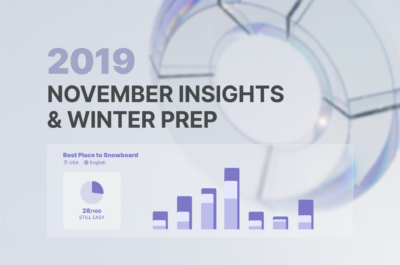Parameters relevant to SEO
Increasing conversions is the ultimate goal of all efforts related to website positioning. However, we need to remember that a conversion can be defined differently depending on the type/nature/specificity of the website. An online store will seek to increase the number of purchases, whereas service-oriented websites will aim to gain more leads. In both cases, […]

Increasing conversions is the ultimate goal of all efforts related to website positioning. However, we need to remember that a conversion can be defined differently depending on the type/nature/specificity of the website. An online store will seek to increase the number of purchases, whereas service-oriented websites will aim to gain more leads. In both cases, one of the most obvious – though not exclusive – indicators to gauge effectiveness is organic traffic. So how can we assess the effectiveness of our efforts based on this indicator? And what else to focus on to determine SEO results?
Accurate definition of measurable goals is one of the key elements of a successful SEO strategy. The goals help verify progress and indicate the next steps that are necessary to ensure the website’s growth. Measures to increase visibility in Google are time-consuming, and typically do not produce measurable outcomes right away, hence the need for constant monitoring the effects of your efforts. Doing so makes it fairly easy to determine progress, although that progress, in spite of expectations, usually does not manifest itself immediately in an increased volume of purchases. The key to properly interpreting the strategy being implemented is to understand that we measure the effects of SEO differently than those of advertising campaigns.
Organic traffic as a key SEO indicator
The objective of implementing SEO measures is always associated with the need to increase website traffic. Monitoring the number of visits from free search results is key to measuring effectiveness in this regard. If we keep track of changes based only on Google Analytics, we may simply overlook them at the beginning of our path to a perfectly optimized website. While this tool is essential to properly monitor a website’s progress, it is not the only one.
It is also a good idea to analyze visibility based on Google Search Console which shows what searches for which the website is listed in Google results and leads (or not) to clicks and visits to the website. With this tool we can easily monitor how the visibility of the website is changing, keeping in mind that organic traffic is generated primarily in the top 3 positions in search results, and the highest positions have the highest click-through rate. It is assumed that the top 3 positions accumulate up to 60% of traffic, so it is worth focusing on strengthening the phrases that are already highly ranked.
Meanwhile, organic results are often skewed by brand-related activities. We can minimize this inaccuracy with the search exclusion feature available in Google Search Console. When we narrow down the results and exclude branded phrases, we get data that is based on non-branded phrases which are largely influenced by our SEO efforts.
Organic traffic measured through Analytics, but also visibility measured through Search Console are two starting points for monitoring the effects of your efforts. But what if you’re just getting started with SEO optimization and your site isn’t generating any traffic yet? How can we track progress beyond visibility in Search Console?
Monitoring the website’s position
The analysis of the website progress should also be based on monitoring its position for key phrases. Naturally, higher rankings in search results will mean more visits to your website and, eventually, more conversions. Position monitoring allows you to check the current position of your website and verify the results in SERPs after making changes to your website. This, in turn, allows you to determine where you stand and, as a result, improve your SEO strategy by revealing the measures that produce the best results.
In addition to monitoring a specific list of key phrases, it is also a good idea to use tools that indicate the phrases for which specific subpages of the website are displayed. Today, with semantic search, a single subpage can be displayed for hundreds of phrases. It is worth to check the list of ranking words for a given subpage every now and then – it will help you plan further actions and keep improving your strategy.

Website loading time
Loading time is a parameter that determines the quality of a website, especially if you are working on its technical aspects. The PageSpeed parameter is one of the main ranking factors used by Google. This means that if a page takes a few seconds longer to load than a competitor’s page, it will rank much lower in search results. Loading time is not only important for Google and search engine robots, but also for users who quickly give up exploring a website if it doesn’t load in a few seconds. Research shows[1] that as many as 80% of users are less likely to repeat a purchase on a particular website because of their negative experience with waiting too long for the content to load. It is worth improving the PageSpeed if you want to rank higher in Google, and tracking it if the speed is not at a satisfactory level and you want to see how the website’s positioning will improve when you work on it.
Backlinks
The number of backlinks is a parameter – much like the load time – that directly translates into the website’s ranking in search results. However, the sites that provide links may not be equal with one another. This means that acquiring backlinks from low quality sites in terms of SEO will not translate into improved visibility of the site being linked to. You should check the origin of your links, ensure a wide range of domains that provide the links and avoid toxic links, i.e. those that may harm the domain by weakening the quality of the link profile.
Google-independent parameters
Most of the recognized SEO tools that assist professionals in their daily work of continuous optimization of websites, feature proprietary parameters that serve as a converter of multiple variables. They allow for a quick comparison of the authority of a particular domain relative to all the sites included in the tool’s database. The correlation between parameters determining domain authority and the number of ranking key phrases, acquired links and their quality are very visible, therefore it is worth using this value when comparing different websites and tracking the effects of SEO activities. Most tools feature a proprietary parameter – Semrush uses Authority Score, Moz uses Domain Authority, and Ahrefs uses Domain Rating. They all use a 100-point scale, and the higher the score at the start, the less noticeable the progress – an increase from 50 to 60 is not equivalent to an increase from 10 to 20.
Monitoring the aforementioned SEO parameters is an integral factor in implementing the strategy. Changes and fluctuations in individual parameters are a signpost for further steps, so to get maximum results, it is worth taking the time to carefully analyze them.
[1] https://blog.kissmetrics.com/app/uploads/2011/04/loading-time.pdf


